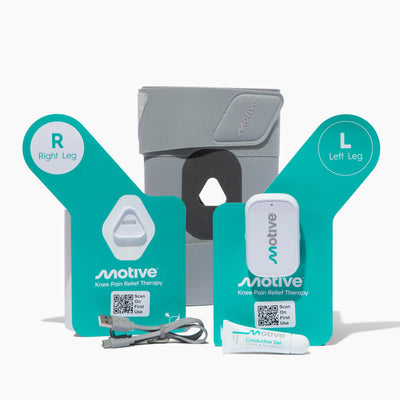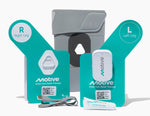
Did you know every year in the United States, acute knee pain results in more than one million visits to the emergency department and over 1.9 million visits to primary care clinics?
Knee pain has become one of the most common problems disrupting people’s daily routines. People over the age of 50 are especially prone to knee pain and may have trouble walking, sitting, standing, or doing even the simplest of tasks. The pain is not only impacting people physically but also mentally.
Knee pain can begin after a traumatic knee injury of torn cartilage, ruptured ligaments, or medical diseases, such as osteoarthritis, rheumatoid arthritis, and gout.
Mild levels of knee pain can be managed at home through self-care, physical therapies, light exercises, or wearing knee braces. However, if you don’t feel relief or your pain worsens it’s recommended to consult an orthopedic doctor to address your knee problems.
The knee joint consists of three major bones:
- Femur: the upper leg bone or thighbone
- Tibia: the lower leg bone or shin bone
- Patella: the kneecap
In addition, the meniscus sits on the tibia and acts as a shock absorber to protect the knee from any quick movements. Further, the quadriceps muscles and hamstring muscles help in straightening and bending legs.
Any issues from wear and tear to medical conditions can affect the knee joint, causing knee pain.
Strengthening muscles around the knee is one of the most effective approaches to treating knee pain, and the FDA-cleared Motive therapy is designed to do just that. It contracts your quadriceps muscles (the same way you do while exercising) and strengthens them to minimize the pressure on your knees.
In this article, we will review the causes of knee pain, their symptoms, available treatments, and the role of Motive in offering lasting knee pain relief.
Unraveling the Causes of Knee Pain
One of the most common causes of knee pain is osteoarthritis. However, there are many other causes that lead to severe knee problems, such as:
- Arthritis: Different types of arthritis cause knee pain, including rheumatoid arthritis, osteoarthritis, and posttraumatic arthritis.
- Injuries: Torn cartilage, meniscus tear, bursitis, dislocation, sprain, anterior cruciate ligament or ACL injuries, and ligament injuries can all cause knee pain.
Figure: an illustration of an anterior cruciate ligament (ACL) injury.
- Overuse or sports injuries: Knee pain that occurs due to overuse includes medial collateral ligament (MCL) tear, Runner’s knee, tendinitis (pain in patellar tendon), Bursitis (inflammation of Bursa or a fluid-filled sac), Shin splints, Osgood-Schlatter disease (in children), and patellofemoral pain syndrome.
Figure: an illustration of a medial collateral ligament (MCL) tear.
Knee problems vary by individual and medical condition impacting the muscle or bone within the knee. If you experience knee pain, swelling and stiffness, weakness or instability, redness, or popping or crunching noise, it’s best to consult a doctor.
Traditional Treatment Options
Many treatment options are available today to treat knee pain. However, to provide the best treatment, healthcare providers must diagnose the root cause of the pain through physical exams combined with imaging techniques, such as:
- X-ray
- Magnetic resonance imaging (MRI)
- Computed tomography scan (also called a CT or CAT scan)
- Radionuclide bone scan
- Arthroscopy
Treatments include:
- Medications: Many over-the-counter topical creams and oral medicines are available to treat knee pain. NSAIDs (or nonsteroidal anti-inflammatory drugs), such as ibuprofen and naproxen (Aleve) help reduce inflammation and pain. Some anti-inflammatory medications, such as Diclofenac (Voltaren) and Meloxicam (Mobic) can also be used. However, their uses require a doctor’s prescription.
- Physical therapy: This is an effective and non-invasive way to treat knee pain. Some therapies suggested by physiotherapists may include wearing knee braces, kneecap taping, and/or an exercise program. Exercises, such as inner thigh stretches, standing knee lifts, squats, straight leg raises/lifts, and standing hamstring curls, are great exercises to get knee pain relief when added to your daily routine. It’s best to consult a physiotherapist to understand what kind of physical therapy can help your knee pain.
- Injections: In some cases, doctors recommend Corticosteroids, hyaluronic acid, or platelet-rich plasma (PRP) injections to reduce inflammation and ease knee pain. However, they may cause side effects.
- Surgery: It is not recommended for everyone, but it may be necessary for those with severe knee pain issues. It’s important to consider the advantages and disadvantages of both nonsurgical recovery methods and surgical reconstruction with your doctor. Some common surgeries include partial knee replacement, total knee replacement, arthroscopic surgery, and osteotomy.
The Role of Muscle Strengthening in Knee Pain Relief
Quadriceps muscles serve as a powerhouse for your knee, playing a vital role in supporting the joint and managing knee pain. Thus, strengthening these muscles can provide a great level of comfort and pain relief.
The muscles around the knee can be strengthened by exercising. However, this might not be a suitable option for all people. In most cases, you will need approval from your doctor, and many times they will caution patients from exercising so as to not make their injury worse.
Knee pain can also be treated temporarily through a Transcutaneous Electrical Nerve Stimulation (TENS) device. These devices only block pain signals while in use, so it’s not effective for long-term knee pain relief.
Another approach is using Neuromuscular electrical stimulation (NMES) therapy. The NMES devices, such as Motive Knee, use electric currents to contract target muscles. This stimulation aids in enhancing and preserving muscle strength and increasing range of motion. They also help in preventing muscle atrophy.
Motive therapy addresses a primary cause of knee pain—muscle weakness. By strengthening muscles around the knee, the device helps minimize stress on the knee and offers lasting knee pain relief when used for 30 minutes per day, as recommended by orthopedics.
Tips for Empowering Self-Management
Surgery, medications, or injections are not always required to treat knee pain. You can treat early knee pain conditions or mild knee pain by managing them carefully. For example, incorporating simple exercises, yoga, and a healthy diet into your daily routine can help you self-manage knee pain. Exercising helps strengthen muscles and support and stabilize knee joints. Always consult a physiotherapist before beginning an exercise program if you are experiencing knee pain.
However, if you are looking for a drug-free, non-invasive approach to knee pain relief, Motive Knee is an effective alternative. The FDA-cleared therapy is a first-of-its-kind to provide stimulation therapy over the counter, without a prescription. It’s recommended by orthopedics and endorsed by thousands of customers.
Since this therapy doesn't require a doctor's prescription, you can buy and use it at your convenience for a recommended 30 minutes a day. You can set the stimulation level based on your knee pain and track the treatment progress through the MyMotive app.
Motive is a solution to long-term knee pain relief that can be achieved in the comfort of your home.
Motive is Your Comprehensive Solution for Knee Pain
Knee pain is a growing concern not only among the elderly but people of all ages. It can lead to difficulty in performing daily activities, such as walking, standing, or sitting for long periods of time.
The cause of knee pain can be from knee injuries, arthritis, or overuse of knee joints, such as in sports. These conditions can be treated by using medication, physical therapy, or supplements. However, these therapies are not fit for all conditions and require consultation.
Among all available knee pain treatments, Motive Knee—an FDA-cleared muscle stimulation therapy device—provides customers with lasting pain relief.
The device uses a proprietary form of NMES (Neuromuscular Electrical Stimulation) to treat pain and heal injured and weak muscles. It doesn’t require a prescription, is easy to use, and can be applied while watching TV or enjoying your morning cup of coffee.
The device is controlled through the MyMotive app. It will guide you through onboarding and daily sessions, provide recommended stimulation levels, and prepare metrics to help you monitor your knee pain.
Motive therapy is a comprehensive solution to get long-term knee pain relief with just 30 minutes of daily use.
So, are you ready to reclaim your life? Get your Motive therapy today.
Have questions about the device? Feel free to reach out to us here!





